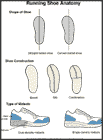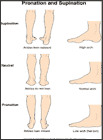
Running Shoes: Finding the Right Fit
With all the different makes and models of running shoes, it's no wonder people have a difficult time finding the shoe that's right for them. Everyone's feet are shaped and sized differently, so what might feel comfortable for one person, might feel uncomfortable for the next. The first step in finding the right shoe is to determine your foot type.
What is my foot type?
When you step, your foot first contacts the ground on the outside of your heel (supination) and then rolls to the inside of your foot (pronation). As your weight continues forward and your heel comes off the ground, the foot rolls to the outside again. Most people do not walk perfectly and tend to put more of their body weight on either the inside or the outside of their foot when they walk. If your foot leans too far to the outside when you walk, it is called over-supination. If your foot leans too far to the inside, it is called over-pronation.
You probably over-supinate if:
- you have a tendency to walk on the outside of your foot
- you have a high arch (even after putting weight on your foot)
- the bottom of your shoe is more worn on the outside.
You probably over-pronate if:
- you have a low arch (when putting weight on your foot)
- your ankle rolls inward when you walk
- you have calluses under your big toe or ball of your foot
- the sole of your shoe is worn out on the inside.
Some people just slightly pronate or supinate. If you can't tell if you pronate or supinate, you probably have a fairly neutral foot.
What is the right shoe for me?
Once you've identified your foot type it's time to find the right shoe. If you're a pronator, you'll need a shoe that will provide some degree of motion control and stability. A shoe that is too flexible will not give you the support that you need. For supinators, a shoe with good cushioning is important.
There are 3 main features of a shoe that you need to consider when selecting a running shoe: shape, type of construction, and midsole.
Shape
Shoes are built on either a curved-last or a straight-last. Look at the bottom of your shoe and draw a straight line from the middle of the heel to the top of the shoe (as if you were slicing the shoe in half). If the shoe has a curved-last, the line will not pass through the tip of the shoe. Instead, you will see that the shape of the shoe has a curved appearance. The right side of the shoe will not look the same as the left. If you have a straight-lasted shoe, the line that bisects the heel will run through the tip of the shoe. The right half of the shoe will look about the same as the left half. A perfectly straight-lasted shoe is not that common but you will notice that some shoes are straighter than others. If you supinate, you might find that a curve-lasted shoe is more comfortable for you, because it can conform better to the shape of your foot.
Construction
There are several methods of shoe construction that affect the overall stiffness of the shoe. Look inside a shoe and pull out the padded insert. You will notice that the shoe is constructed using either a slip-last or a board-last. In a slip-lasted shoe the fabric of the shoe is sewn together. You will see stitching running down the middle of the inside of the shoe. In a board-lasted shoe, the bottom of the shoe is covered with cardboard. Some shoes are combination-lasted. In this kind of shoe, the part of the shoe toward the heel is covered with cardboard and the part toward the toe is stitched. Slip-lasted shoes tend to be more flexible and therefore are good for supinators. Board-lasted shoes tend to be stiffer and better for the pronator. For someone whose foot type is fairly neutral, a combination-lasted shoe might be a good choice.
Another part of the shoe to consider is the heel counter. The heel counter is the part of the shoe that cups around your heel. All good running shoes should have a firm heel counter. Test the heel counter by pushing on it. If it is firm, it should be difficult to deform its shape.
Midsole
The midsole is the base of the shoe. It provides the cushioning and shock absorption. There are many different midsole materials. A midsole made of a heavy or dense material provides more stability, but less cushion. If you pronate, you might consider a shoe with a dual-density midsole. This provides some shock absorption, as well as some stability. You can often tell if a shoe has a dual-density midsole because the midsole will be two different colors. The darker color is the stiffer material and is usually on the heel part of the shoe. Single density midsoles offer good cushioning but are not great at providing stability. These are better for supinators.
How often should I replace my running shoes?
Midsoles tend to lose their effectiveness after 600 miles of use, depending on how much you weigh and the material used in the shoe. Some runners buy two pair of shoes at a time and alternate them from day to day. This method is fine; however, it's also important to note that shoes have a "shelf-life." The midsole will eventually lose its ability to absorb shock, even if the shoes haven't been worn for several years.
Remember, brands and styles change every year, so the shoe that works for you this year might not be the best shoe for you next year.


